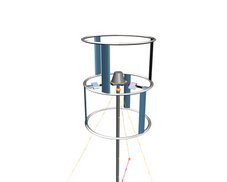
What will it take for distributed wind startups to generate the "hype" cycle presently feeding solar power cleantech investments...
First and foremost, I think the "game changes" when clean energy is needed for power, not aesthetics, social conciousness, LEED certificates, or green eco-business. In other words, when your power is costly, or unreliable, or unattainable. Let's call this - real "power crunch" time, that's when small wind power could be very compelling.
#1. In power crunch, we won't use the near-worthless notion of "nameplates". (Comparing systems by their peak power output under best conditions.) Instead, yearly power output will be used. (think $/yearly kWh instead of $/watt). Wind power delivery is more consistent, and the power delivery over the year is substantially better (2-3x) than the nameplate comparisons of wind "vs" solar. By this math, in good wind sites, wind is already 10x better than solar (3x cheaper on 1kwh and 3x more productive)
#2. Wind turbines rely on many of the same burdened cost structures as solar. A million solar homes are going to create lots of shared economies of scale for wind. That means cost reductions to inverters make small wind more compelling as well. Of those million homes, if some enlightened system integrators start doing "hybrid" installs in good wind sites, that alone could drive demand for 50,000-100,000 turbines.
#3. All power is geography. When power becomes more precious/scarce, we'll be forced to pay more attention to geography. That means, we'll take tidal power under bridges, solar power in strong sun, and wind power in high wind. More importantly, we'll pay attention to watts/meter (sorry, that should be: yearly kwh/meter). In urban settings, (such as tall rooftops) wind can achieve on the order of 10x the energy ouptut per square meter. Again, nobody is paying attention to energy footprints in linear feet, but it will come when the decision making is driven more by economics.
#4. Related to geography is of course, application. There are applications where wind and only wind can deliver power (think cell towers or mountain top army bases) Having congress drive small wind is important and useful. I think a bigger/better role may take place inside green design. (LEED and Green Buildings Council) That group can best overcome siting/aesthetics and also help penetrate vibrant and exploding mid-scale commercial market.)
As proof, you already see tremendous "love" for wind in rest-of-world. Small wind purchasing in China and India, are growing like gangbusters. Those buyers presumably have considerably higher economic and reliable supply issues, and have probably never measured anything on a nameplate basis :)
What happens if there isn't a power crunch? Well, the whole bet is probably "off" for all cleantech if the only market forces are social and not economic.
p.s. would also love to see the name change from "small wind" to "distributed wind". The irony of calling sub 100kw wind power 'small 'just goes to show how incredibly biased we are to solar. (How many solar installs as a percentage of solar are >100kw?)
Thursday, March 15, 2007
Will distributed or small wind every be a feeding frenzy for VCs?
Posted by
Jeremy Stieglitz
at
12:21 PM
![]()
Labels: Venture Investing in Wind
Subscribe to:
Comment Feed (RSS)




|